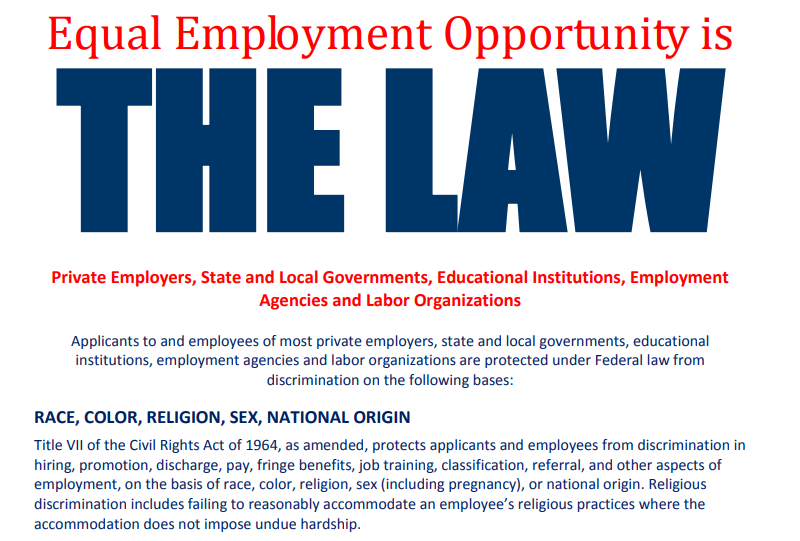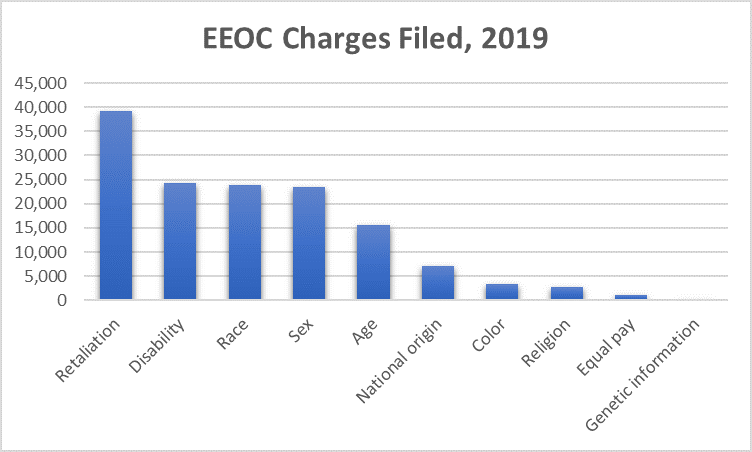A Small Business Guide to Equal Employment Opportunity
The best reason to cultivate a diverse, inclusive workforce is that it helps your business succeed, as demonstrated by two recent studies by McKinsey & Company. An inclusive work environment broadens your talent pool, enhances the employee experience, improves customer service, and drives innovation.
If you’re like many business owners, you might think equal employment opportunity (EEO) is a given. Why wouldn’t you bring the best and the brightest on board? Yet it takes more than a commitment to the idea of equal opportunity to promote an inclusive workplace.
It takes careful planning, a solid framework, and active engagement. This article will help you translate good intentions into concrete actions to create an inclusive workplace.
Overview: The history and evolution of equal employment opportunity (EEO)
The EEO movement has its roots in the Equal Pay Act of 1963, which required men and women doing substantially equal work to receive equal pay.
That law was quickly followed by Title VII of the Civil Rights Act of 1964 (Title VII), which prohibited employment discrimination and created the Equal Employment Opportunity Commission (EEOC).
Title VII specifically barred discrimination based on race, color, religion, sex, or national origin in hiring, firing, layoffs, compensation, benefits, promotions, training, and other terms and privileges of employment. The law also prohibited retaliating against employees who file discrimination complaints.
Over time, additional classes of workers were protected against discrimination with the Age Discrimination in Employment Act of 1967 (ADEA), which protects employes over 40; the Pregnancy Discrimination Act of 1978 (PDA), which amended Title VII; the Americans with Disabilities Act of 1990 (ADA); and the Genetic Information Nondiscrimination Act of 2008 (GINA).
On June 15, 2020, the U.S. Supreme Court issued a landmark decision that Title VII’s sex discrimination protections encompass sexual orientation and gender identity. Previously, LGBTQ employees were protected from discrimination in fewer than half of states.
The Court ruled that “it is impossible to discriminate against a person for being homosexual or transgender without discriminating against that individual based on sex.”
Since their enactment, EEOC laws have been continually tested and reinterpreted by the courts. For example, in 2007, the U.S. Supreme Court ruled in Ledbetter v. Goodyear that employees had 180 days from receiving a new salary or raise to file a pay discrimination complaint.
In other words, after six months without complaining, you were out of luck. In 2009, the legislature fired back with the Lilly Ledbetter Fair Pay Act, which basically reset the statute of limitations on complaints with every paycheck.
Employees can now challenge a pay disparity even if they have been paid at that salary for years.
This poster from the EEOC meets the requirements for posting EEO information prominently in the workplace. Image source: Author
How to set up and follow EEO guidelines in your business
So how can a small business ensure EEO compliance across all HR processes? These five steps will help you become a true equal opportunity employer.
Step 1: Avoid hiring and screening bias
To ensure an inclusive hiring process, you need to actively pursue diversity with every hire. These tips will help you get there:
- Limit tests: Use screening tests only if they relate directly to the job requirements.
- Check your assumptions: Check human resources (HR) metrics to detect any unintended bias. Is your hiring process disproportionally screening out a protected class of workers? Can you make it more inclusive?
- Scrutinize interview questions: You are not allowed to ask about protected characteristics such as age, religion, or disability in an interview. If a candidate brings it up and asks for an accommodation to make the work accessible, you can discuss the request. Otherwise, don’t go there.
- Leave the door open: If a candidate asks for an accommodation, such as a day off for a religious observance, you’re required to provide it if you can do so without undue business hardship. You’re also barred from making hiring decisions based on the request. You don’t have to commit to an accommodation on the spot, but you should offer to look into it and then proceed as you would with any other candidate.
- Pursue diverse candidates: If you’re not getting diverse job applicants, try mixing up your small business recruiting tactics. Look for platforms and venues that recruit from diverse talent pools.
Step 2: Audit pay and benefit practices
The law requires equal pay for substantially similar work. Consider these tips to ensure that your employees are being rewarded for their contributions:
- Check pay stats: At least annually, run an audit of compensation based on sex, race, ability, and other protected characterstics. Are they truly equal? Can you point to concrete reasons for pay levels of employees in similar positions?
- Audit benefit usage: Are your benefit packages attracting a certain kind of employee? Are they being accessed equally by all employees? Could you offer benefits that might broaden the appeal of your offer?
- Use software: HR software makes it easy to track key stats on pay and benefits.
Step 3: Examine performance reviews and promotions
Many discrimination complaints come from employees passed over for promotion. Make sure you’re developing your talent to its full potential with the following tips:
- Be consistent: Use an objective performance evaluation process such as a numeric rating system to promote consistent reviews.
- Document decisions carefully: Documentation is critical to ensure fairness and to defend your decisions if necessary.
- Root out unintended bias: Audit promotions along with pay at least annually to detect unintended or systemic bias. Are you making an effort to develop and promote employees from all groups?
- Train front-line supervisors: Be sure to address discrimination in performance appraisals during leadership training.
Step 4: Prevent harassment
It’s tempting to think of harassment in terms of overtly hostile actions such as inappropriate sexual overtures, offensive speech, and bullying. But the EEOC defines harassment as “unwelcome conduct” based on sex, religion, or other protected characteristics.
A pattern of unwelcome conduct creates a hostile work environment and opens you up to discrimination charges. To avoid that fate, consider these best practices:
- Train everyone: Provide anti-discrimination training during onboarding and follow up with periodic training for all employees. Everyone in your company should understand that any unwelcome speech or action surrounding protected classes may be considered harassment. It doesn’t have to be overtly hostile or disparaging.
- Provide extra manager training: Managers need hands-on training with concrete examples to illustrate the line between acceptable and unacceptable behaviors.
- Embrace difference: Far from cramping people’s style, avoiding harassment creates a professional atmosphere where people can feel free to speak their minds. Encourage employees to bring diverse ideas, opinions, and cultures to work while respecting personal boundaries.
- Respond to complaints: Managers should stop inappropriate behavior in its tracks and respond promptly to complaints. They should also follow a written disciplinary policy to address harassment.
Step 5: Steer clear of retaliation
Employers can’t take diverse actions against employees in response to a discrimination complaint. To avoid retaliation, consider the following:
- Do your due diligence: Investigate all complaints, even if you believe they are baseless and document your findings.
- Prevent retaliation: No one is happy to receive a complaint, but you really need to welcome them if you want a functional, diverse workplace. Employees must feel free to speak up, and managers need to understand that retaliation is not just a violation of company policy — it’s illegal.
- Provide multiple avenues: Give employees more than one point person for complaints to ensure that they can reach out to someone they feel comfortable with.
- Avoid bad timing: Even if you have cause for disciplinary action, if someone has lodged a complaint, hold off for at least 90 days. When you do act, make sure you have followed the written policy to the letter and have ample documentation to support your decisions.

As this chart shows, retaliation is the most common type of complaint filed with the EEOC. Image source: Author
FAQs
- Which EEO laws apply to small businesses?
- Do I have to make special accommodations for employees in protected groups?
- What does disparate impact mean?
Bring in the best and brightest
EEO is very much what you make it. You can look at it as a bunch of legalistic snares you have to navigate as part of HR compliance. Or you can use it as a framework for creating a better employee experience and a more successful business. The opportunity is yours.
This article was originally published here.
